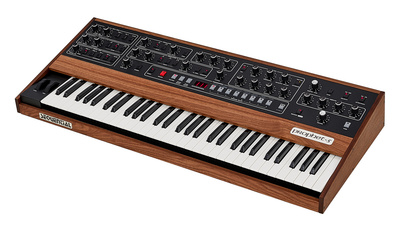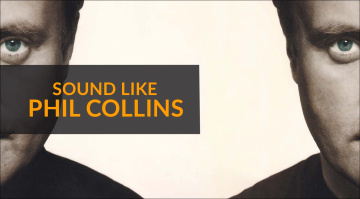I Can Feel It: How To Sound Like Phil Collins
The expansive sound of the early Phil Collins records.
We look into the creative process of world-renowned and critically acclaimed drummer, singer, songwriter, and producer Phil Collins.
After developing a reputation as a session drummer and a key member of the English progressive rock band, Genesis, Phil Collins began his career as a solo artist.
The Phil Collins Sound
He may have been unaware, but looking back, the timing of this foray was ideal. The period in the late 1970s and early 1980s was completely revolutionary for the recording industry, with so many new creative musical tools introduced onto the market.
Another interesting aspect of Phil Collins’ approach to music production is that he never intended to write hits initially. Rather than fame or commercial success, he simply saw his solo project as an artistic outlet that offered him the freedom of expression he wanted.
Roland CompuRhythm CR-78
Introduced by Roland in 1978, the CompuRhythm CR-78 was the first-ever microprocessor-controlled drum machine. Although limited, it has the ability to select and vary 34 different rhythm patterns.

With its intuitive interface, the CR-78 became an absolutely integral part of Phil’s songwriting process. He would start by selecting the rhythm part with the right “atmosphere” as he put it, and setting the tempo to match the feel he had in mind.
With the tape machine running, the CR-78 was always positioned just next to Phil’s drum kit. This way, he could play drums and sing over the unrelenting loops created by the CR-78, building ideas and arrangement concepts as he went.
If you’re looking for the classic CompuRhythm sound with all its familiar drum patterns, the Cherry Audio CR-78 plug-in provides an easy way to recreate it in your DAW.


Sequential Circuits Prophet-5
When Phil went solo in the late 1970s, there wasn’t a massive range of polyphonic synths available like we have today. That being said, many of us would likely still prefer a Prophet-5 over many modern options.

The illustrious Prophet 5 was still quite new on the market when Phil began work on his debut album. With its simple controls and 5-voice architecture, you can generate anything from innocuous to outrageous sounds.
The beauty of the Prophet is that it’s easy to program, and like the Oberheim OB-8 he also acquired later, it always managed to sound interesting, whether it was placed in the background or the foreground of the mix.
You can hear the famous Prophet-5 chord sequence in the intro of In The Air Tonight, where it becomes the foundation of the song, along with the CR-78. The Sequential Prophet-5 is still in production as a reissue that can mimic the original’s various revisions.


Roland VP-330 Vocoder Plus
The VP-330 Vocoder Plus is another exciting instrument used by Phil Collins on his debut solo recordings, notably on In The Air Tonight. This sought-after instrument combines a paraphonic 10-band vocoder and a string synthesizer.

With the VP-330, you don’t actually have access to control each individual band. However, the presets sound great, and when combined with the BBD Ensemble effect, you can produce a hauntingly beautiful sound.
The fact that the VP-330 is relatively easy to use would have suited Phil nicely when putting together his first record, Face Value. His improvisational song and lyric writing style relies on spontaneity, so highly technical interfaces can sometimes hinder this.
As a modern alternative, the Behringer VC340 gives you the same authentic sound with an almost identical interface. Its limitation could well be a catalyst for creativity when making any style of music.
- More about Behringer clones


SSL Listen Mic Compressor
Like most of the creatively groundbreaking aspects of the early Phil Collins records, the ideas came together while simply “messing around”. Similarly, the famous Phil Collins gated drum sound has an origin story that is also unintentional.

In 1979, engineer Hugh Padgham was working on a Phil Collins drum session for Peter Gabriel’s third solo album at Townhouse Studio in London. By accident, the talkback mic was left active while Phil was playing, resulting in a thunderous effect.
As the talkback circuit in the SSL 4000 B console couldn’t be patched into the recording path, Padgham promptly rewired it, allowing his mistake with the Listen Mic Compressor to be used creatively.
What we hear on the subsequent Phil Collins drum recordings is a more evolved version of this, with the addition of the recording console’s noise gate implemented.
- More about Analogue Consoles


AMS RMX16
The AMS RMX16 is a legendary digital reverb introduced in the early 1980s that Phil Collins was an early adopter of. It offered a selection of great-sounding reverbs and ambiences, with the now legendary non-linear algorithm that worked well on drums.

Once again, the interface is certainly Phil Collins friendly, offering easy operation and the ability to save your own presets. This allows the RMX16 to be used creatively rather than clinically, which suited Phil’s songwriting process.
At the time, there simply weren’t microprocessor-controlled reverb units like the RMX16 around that gave you both precision and flexibility. So it’s no surprise that it’s still a sought-after reverb in both plug-in and hardware format today.
In recent years, AMS Neve has created a 500-series reissue of the RMX16 with a similar interface and the same reverb algorithms, a great addition to any studio setup.
- More about 1980s Reverb


Which of your favourite artists would you like to see in our Sound-alike series? Please let us know in the comments below!
More about Phil Collins:
- Official Artist Page
- More Sound-alikes
*Note: This article contains promotional links that help us fund our site. Don’t worry: the price for you always stays the same! If you buy something through these links, we will receive a small commission. Thank you for your support!
- Roland CR-78: Wikipedia
- Sequential Circuits Prophet-5: Genesis: a gear revelation WIKI
- Roland VP-330: Vintage Synth Explorer
- AMS RMX16: Retrosonic














